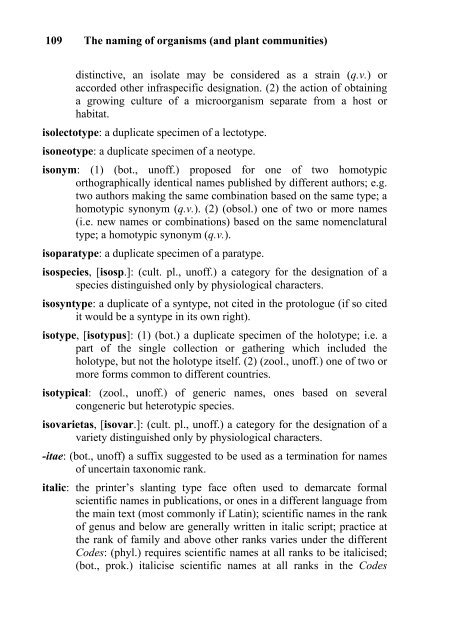Access Resource - Global Biodiversity Information Facility
Access Resource - Global Biodiversity Information Facility
Access Resource - Global Biodiversity Information Facility
You also want an ePaper? Increase the reach of your titles
YUMPU automatically turns print PDFs into web optimized ePapers that Google loves.
109 The naming of organisms (and plant communities)<br />
distinctive, an isolate may be considered as a strain (q.v.) or<br />
accorded other infraspecific designation. (2) the action of obtaining<br />
a growing culture of a microorganism separate from a host or<br />
habitat.<br />
isolectotype: a duplicate specimen of a lectotype.<br />
isoneotype: a duplicate specimen of a neotype.<br />
isonym: (1) (bot., unoff.) proposed for one of two homotypic<br />
orthographically identical names published by different authors; e.g.<br />
two authors making the same combination based on the same type; a<br />
homotypic synonym (q.v.). (2) (obsol.) one of two or more names<br />
(i.e. new names or combinations) based on the same nomenclatural<br />
type; a homotypic synonym (q.v.).<br />
isoparatype: a duplicate specimen of a paratype.<br />
isospecies, [isosp.]: (cult. pl., unoff.) a category for the designation of a<br />
species distinguished only by physiological characters.<br />
isosyntype: a duplicate of a syntype, not cited in the protologue (if so cited<br />
it would be a syntype in its own right).<br />
isotype, [isotypus]: (1) (bot.) a duplicate specimen of the holotype; i.e. a<br />
part of the single collection or gathering which included the<br />
holotype, but not the holotype itself. (2) (zool., unoff.) one of two or<br />
more forms common to different countries.<br />
isotypical: (zool., unoff.) of generic names, ones based on several<br />
congeneric but heterotypic species.<br />
isovarietas, [isovar.]: (cult. pl., unoff.) a category for the designation of a<br />
variety distinguished only by physiological characters.<br />
-itae: (bot., unoff) a suffix suggested to be used as a termination for names<br />
of uncertain taxonomic rank.<br />
italic: the printer’s slanting type face often used to demarcate formal<br />
scientific names in publications, or ones in a different language from<br />
the main text (most commonly if Latin); scientific names in the rank<br />
of genus and below are generally written in italic script; practice at<br />
the rank of family and above other ranks varies under the different<br />
Codes: (phyl.) requires scientific names at all ranks to be italicised;<br />
(bot., prok.) italicise scientific names at all ranks in the Codes









